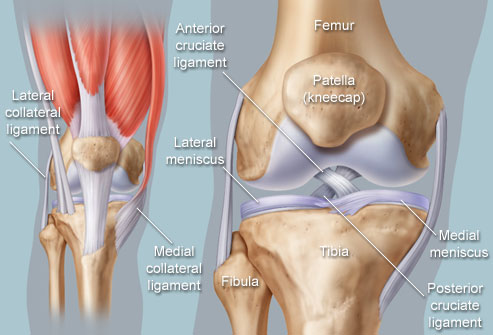It happens to most everyone at some point – you get up, start to walk, and suddenly feel pain in your knee. OR, you are getting a little exercise and POP! You feel something snap in your knee and “Ouch!” Knee injuries and problems are incredibly common and can really be a nuisance. As such, I thought you might benefit from a little review of common knee issues and how to avoid or recover from them.

Typical Knee Injuries
As the largest joint in the body, the knee takes on a lot of stress as it absorbs shock from walking, running, and jumping; and gets a lot of movement from non-impact bending. As a result, most knee problems come from injuries such as abnormal twisting, bending, or a direct blow to the knee. Common acute injuries include:
- Sprains or strains to the soft-tissue that connect and support the knee
- Meniscal tears
- Ligament tears such as the anterior cruciate ligament (ACL) and medial collateral ligament (MCL)
- Kneecap breaks or fractures
- Dislocation of the kneecap or of the knee joint
Overuse Injuries
Considering how much we use our knees for body movement throughout our lifetime, it is not surprising that repetitive activities can create overuse injuries. Common overuse injuries include:
- Bursitis – an inflammation of the sacs of fluid that cushion and lubricate the knee
- Tendinitis – inflammation of the tendons
- Patellofemoral Pain Syndrome – pain in the front of the knee, behind the knee cap
- Iliotibial Band Syndrome – pain and inflammation of the iliotibial band that runs down the outside of the thigh
- Plica Syndrome – thickening of the knee ligaments
Additionally, knee pain can be caused by diseases such as osteoarthritis and Osgood-Schlatter disease, as well as cysts, pinched nerves, and infections in the knee. So, what can you do to avoid or at least minimize knee problems? (You know I am definitely NOT going to tell you to completely stop using them!)
Minimizing Knee Problems
I know people who live with chronic knee pain and problems because they did not take care of their knees correctly. So, while some of these tips may seem obvious, they are not to be taken lightly.
- Protect your knees by wearing knee guards when you are playing sports, rollerblading, or doing other recreational activities or housework such as gardening.
- Exercise regularly. Keep the muscles, tendons, and ligaments around your knee strong. You need to make sure your anterior (front) and posterior (backside) as well as medial (inner side) and lateral (outer side) muscles and tissues are strengthened and stretched equally so your knee joint is not pulled in one direction or the other.
- STRETCH! Especially before and after you exercise, play sports, or engage in an extended activity where your knees are involved such as a long walk or hike, bike ride, swim, etc.
- Wear the right shoes for your particular activity, and/or get inserts that promote proper foot support. A quality running store, such as Jacksonville Running Company, would have a foot analysis machine to get you started, or see a podiatrist to ensure proper form and fit. If your feet are not hitting the floor correctly, it can affect your knees and hips, as well as translate up your spine and start to cause other postural imbalances, and even back or neck pain.
- Avoid activities that stress your knees, such as deep knee bends with improper form, jumping with impact, and downhill running.
- Use proper form when running or playing sports. Consult a sport specific coach, physical therapist, or trusted fitness professional (such as myself) to review your form and help you make any necessary changes.
- Eat healthy foods with calcium and vitamin D to keep bones strong and help deter osteoporosis.
You cannot completely avoid potential knee issues, but by taking the right precautions in advance, you are less likely to have problems, and more likely to heal quickly should they arise.
Recovering From Knee Injuries or Knee Surgery
Everyone recovers at a different rate, and recovery time varies based on the issue and severity. Still, there are some things you can expect for your recovery, and specific areas you should focus on in order to get your knee to optimal functioning.
- Focus first on decreasing swelling and increasing range of motion. For injuries, practice RICE – Rest, Ice, Compression, and Elevation. Ice your knee ten minutes each hour for the first few days, and start working towards full range of motion in between icing. Passive range of motion should be introduced immediately after surgery or injury.
- You can begin isometric exercises for your quadriceps and hamstrings early in your recovery.
- Maintain mobility of your ankles, hips, pelvis, and lumbar spine during your recovery.
- After you have regained full range of motion, add weight-bearing exercises such as step-ups, squats, and lunges. Do these slowly and with minimal weight to start with. Do not overexert yourself or you’ll end up back in the same place or worse.
- Listen to your body – it will tell you what is too much. Don’t try to be a hero.
Overall, make sure you take the time necessary to allow your knee to heal properly. If you do not have full range of motion, don’t try to lift a lot of weight with your legs or run long distances. And, don’t forget, the knee is part of a larger system, so make sure you give it proper support. Strengthen the muscles around the kneecap and those that provide additional support such as quadriceps, hamstrings, obliques, low back muscles, and upper thigh.
You need your knees to last a lifetime, so start taking good care of them NOW!
